fuel pressure CHRYSLER PT CRUISER 2007 1.G Owners Manual
[x] Cancel search | Manufacturer: CHRYSLER, Model Year: 2007, Model line: PT CRUISER, Model: CHRYSLER PT CRUISER 2007 1.GPages: 467, PDF Size: 7.57 MB
Page 114 of 467

Front seat belt assemblies must be replaced after a
collision. Rear seat belt assemblies must be replaced after
a collision if they have been damaged (bent retractor, torn
webbing, etc. If there is any question regarding belt or
retractor condition, replace the belt.
Airbag Light
The light should come on and remain on for 6 to 8
seconds as a bulb check when the ignition switch is first
turned ON. If the LED is not lit during starting, have it
checked. If the light stays on or comes on while driving,
have the system checked by an authorized dealer.
Defroster
Check operation by selecting the defrost mode and place
the blower control on high speed. You should be able to
feel the air directed against the windshield.
Periodic Safety Checks You Should Make Outside
The Vehicle
Tires
Examine tires for excessive tread wear or uneven wear
patterns. Check for stones, nails, glass, or other objects
lodged in the tread. Inspect tread and sidewall for cuts or
cracks. Check wheel nuts for tightness, and tires (includ-
ing spare) for proper pressure.
Lights
Have someone observe the operation of exterior lights
while you work the controls. Check turn signal and high
beam indicator lights on the instrument panel.
Fluid Leaks
Check area under vehicle after overnight parking for fuel,
engine coolant, oil or other fluid leaks. Also, if gasoline
fumes are detected or fuel, power steering fluid or brake
fluid leaks are suspected, the cause should be located and
corrected immediately.
114 THINGS TO KNOW BEFORE STARTING YOUR VEHICLE
Page 229 of 467
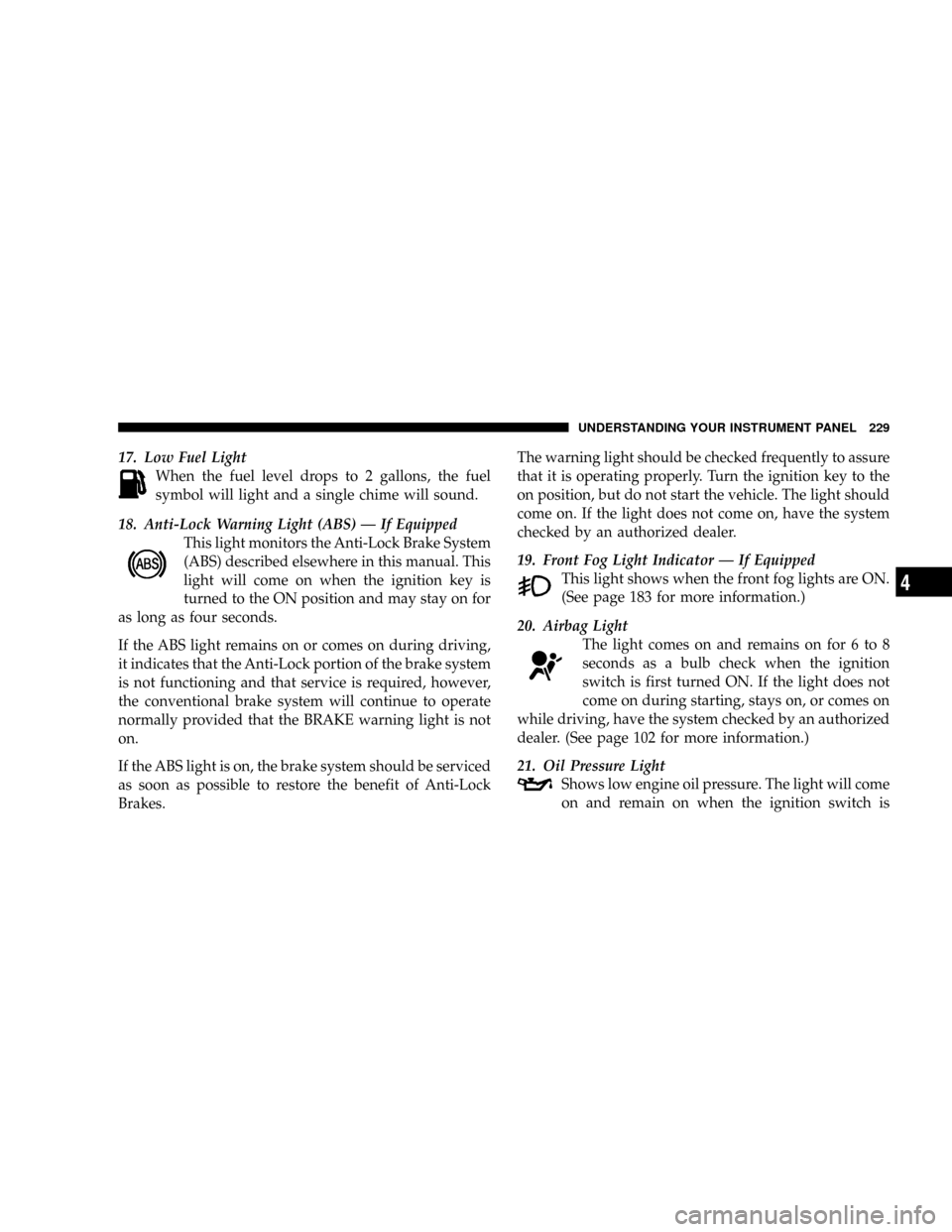
17. Low Fuel Light
When the fuel level drops to 2 gallons, the fuel
symbol will light and a single chime will sound.
18. Anti-Lock Warning Light (ABS) Ð If Equipped
This light monitors the Anti-Lock Brake System
(ABS) described elsewhere in this manual. This
light will come on when the ignition key is
turned to the ON position and may stay on for
as long as four seconds.
If the ABS light remains on or comes on during driving,
it indicates that the Anti-Lock portion of the brake system
is not functioning and that service is required, however,
the conventional brake system will continue to operate
normally provided that the BRAKE warning light is not
on.
If the ABS light is on, the brake system should be serviced
as soon as possible to restore the benefit of Anti-Lock
Brakes.The warning light should be checked frequently to assure
that it is operating properly. Turn the ignition key to the
on position, but do not start the vehicle. The light should
come on. If the light does not come on, have the system
checked by an authorized dealer.
19. Front Fog Light Indicator Ð If Equipped
This light shows when the front fog lights are ON.
(See page 183 for more information.)
20. Airbag Light
The light comes on and remains on for 6 to 8
seconds as a bulb check when the ignition
switch is first turned ON. If the light does not
come on during starting, stays on, or comes on
while driving, have the system checked by an authorized
dealer. (See page 102 for more information.)
21. Oil Pressure Light
Shows low engine oil pressure. The light will come
on and remain on when the ignition switch is
UNDERSTANDING YOUR INSTRUMENT PANEL 229
4
Page 311 of 467

2. EconomyÐ
Improper inflation pressures can cause uneven wear
patterns to develop across the tire tread. These abnormal
wear patterns will reduce tread life resulting in a need for
earlier tire replacement. Under inflation, also increases
tire rolling resistance and results in higher fuel consump-
tion.
3. Ride Comfort and Vehicle StabilityÐ
Proper tire inflation contributes to a comfortable ride.
Over inflation produces a jarring and uncomfortable ride.
Tire Inflation Pressures
The proper cold tire inflation pressure is listed either on
the face of the driver's door or on the driver's side ªBº
pillar.
Some vehicles may have Supplemental Tire Pressure
Information for vehicle loads that are less than themaximum loaded vehicle condition. These pressure con-
ditions will be found in the ªSupplemental Tire Pressure
Informationº section of this manual.
The pressure should be checked and adjusted as well as
inspecting for signs of tire wear or visible damage at least
once a month. Use a good quality pocket-type gauge to
Tire Placard Location
STARTING AND OPERATING 311
5
Page 350 of 467
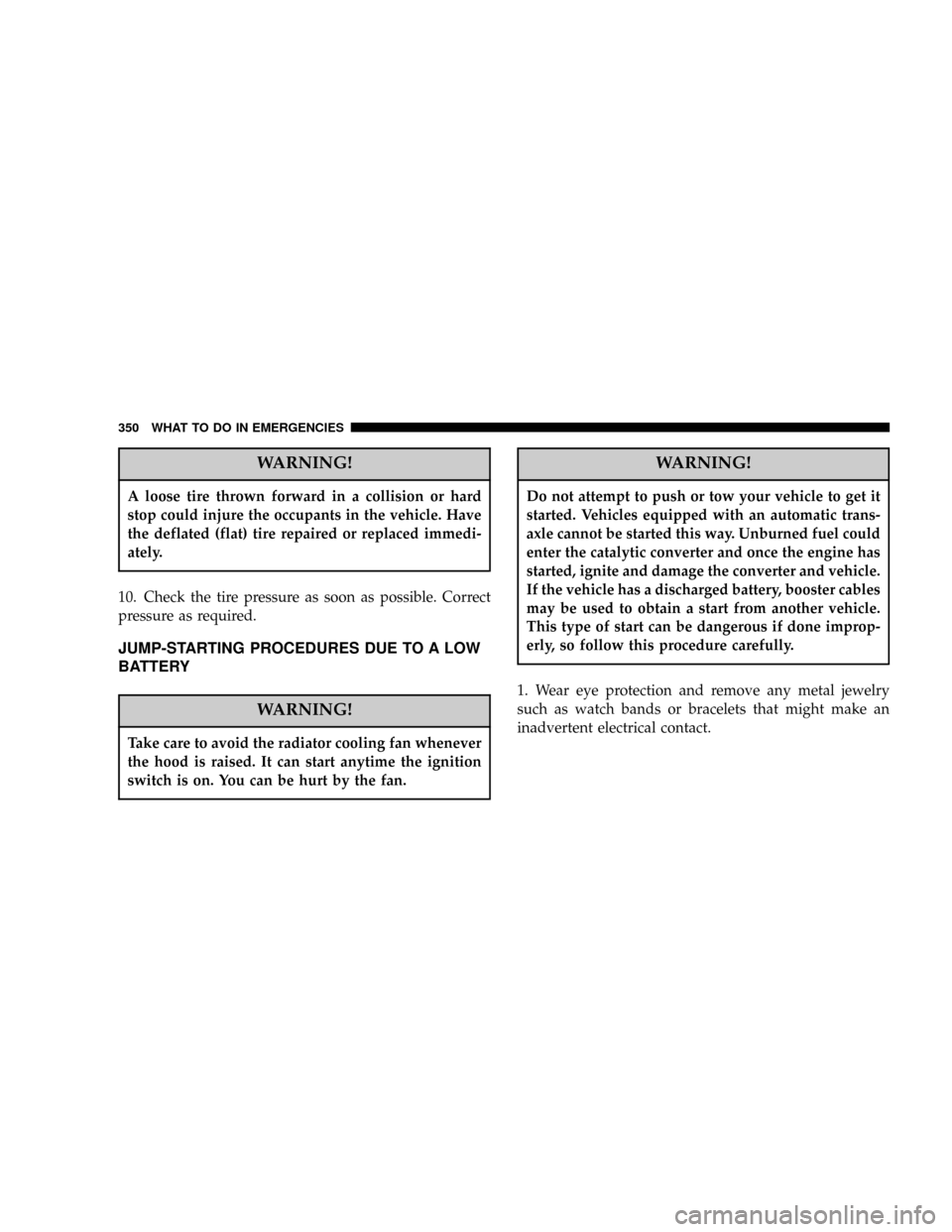
WARNING!
A loose tire thrown forward in a collision or hard
stop could injure the occupants in the vehicle. Have
the deflated (flat) tire repaired or replaced immedi-
ately.
10. Check the tire pressure as soon as possible. Correct
pressure as required.
JUMP-STARTING PROCEDURES DUE TO A LOW
BATTERY
WARNING!
Take care to avoid the radiator cooling fan whenever
the hood is raised. It can start anytime the ignition
switch is on. You can be hurt by the fan.
WARNING!
Do not attempt to push or tow your vehicle to get it
started. Vehicles equipped with an automatic trans-
axle cannot be started this way. Unburned fuel could
enter the catalytic converter and once the engine has
started, ignite and damage the converter and vehicle.
If the vehicle has a discharged battery, booster cables
may be used to obtain a start from another vehicle.
This type of start can be dangerous if done improp-
erly, so follow this procedure carefully.
1. Wear eye protection and remove any metal jewelry
such as watch bands or bracelets that might make an
inadvertent electrical contact.
350 WHAT TO DO IN EMERGENCIES
Page 369 of 467
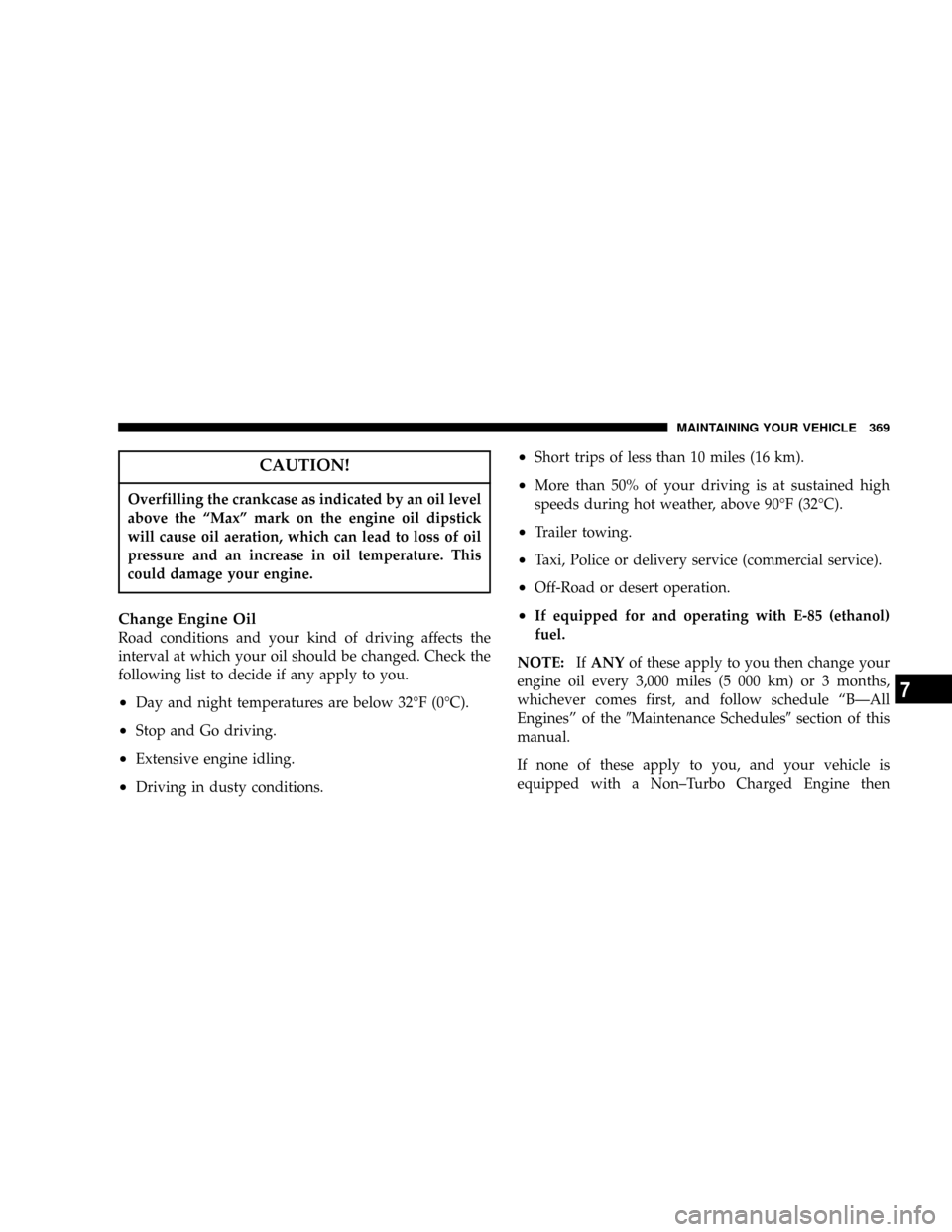
CAUTION!
Overfilling the crankcase as indicated by an oil level
above the ªMaxº mark on the engine oil dipstick
will cause oil aeration, which can lead to loss of oil
pressure and an increase in oil temperature. This
could damage your engine.
Change Engine Oil
Road conditions and your kind of driving affects the
interval at which your oil should be changed. Check the
following list to decide if any apply to you.
²Day and night temperatures are below 32ÉF (0ÉC).
²Stop and Go driving.
²Extensive engine idling.
²Driving in dusty conditions.
²Short trips of less than 10 miles (16 km).
²More than 50% of your driving is at sustained high
speeds during hot weather, above 90ÉF (32ÉC).
²Trailer towing.
²Taxi, Police or delivery service (commercial service).
²Off-Road or desert operation.
²If equipped for and operating with E-85 (ethanol)
fuel.
NOTE:IfANYof these apply to you then change your
engine oil every 3,000 miles (5 000 km) or 3 months,
whichever comes first, and follow schedule ªBÐAll
Enginesº of the9Maintenance Schedules9section of this
manual.
If none of these apply to you, and your vehicle is
equipped with a Non±Turbo Charged Engine then
MAINTAINING YOUR VEHICLE 369
7
Page 387 of 467
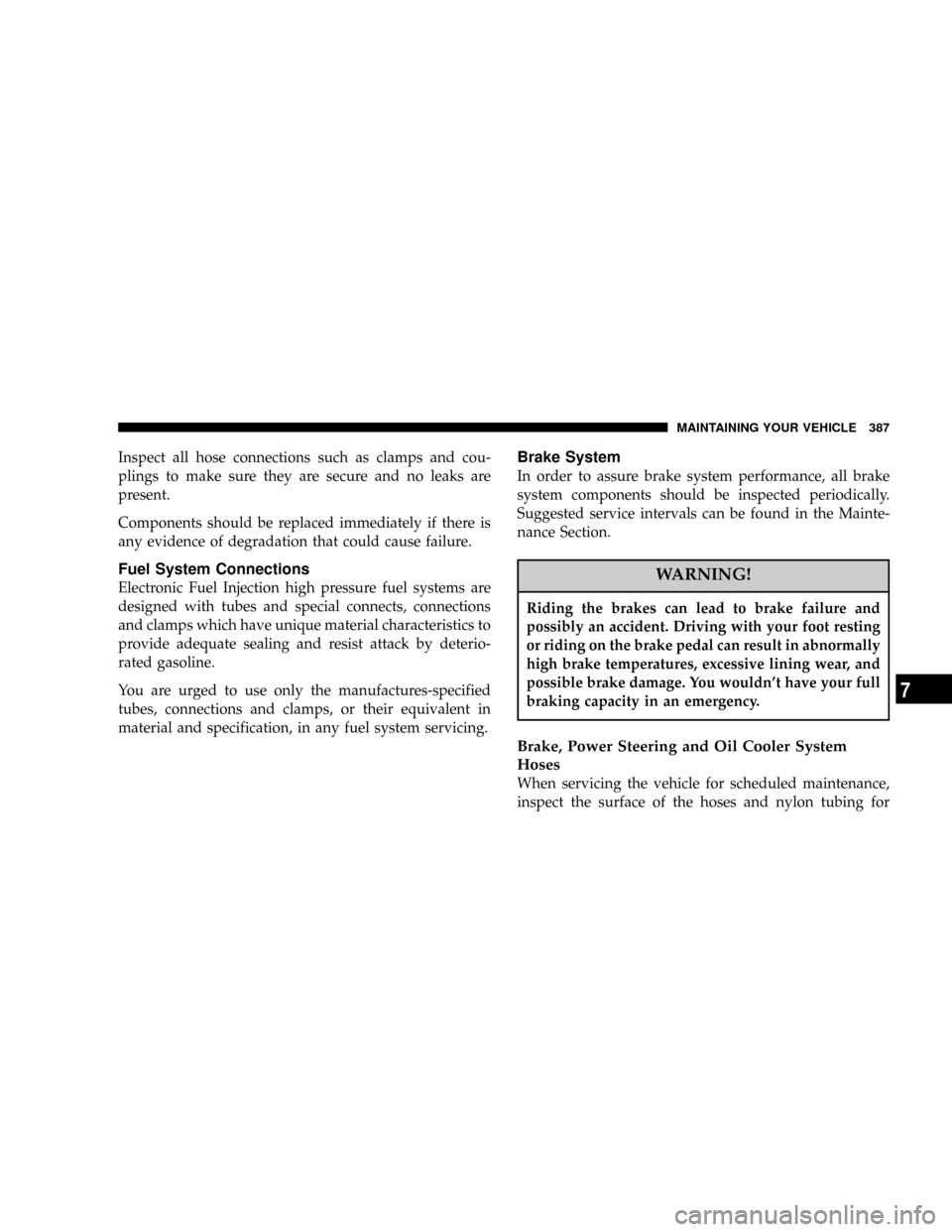
Inspect all hose connections such as clamps and cou-
plings to make sure they are secure and no leaks are
present.
Components should be replaced immediately if there is
any evidence of degradation that could cause failure.
Fuel System Connections
Electronic Fuel Injection high pressure fuel systems are
designed with tubes and special connects, connections
and clamps which have unique material characteristics to
provide adequate sealing and resist attack by deterio-
rated gasoline.
You are urged to use only the manufactures-specified
tubes, connections and clamps, or their equivalent in
material and specification, in any fuel system servicing.
Brake System
In order to assure brake system performance, all brake
system components should be inspected periodically.
Suggested service intervals can be found in the Mainte-
nance Section.
WARNING!
Riding the brakes can lead to brake failure and
possibly an accident. Driving with your foot resting
or riding on the brake pedal can result in abnormally
high brake temperatures, excessive lining wear, and
possible brake damage. You wouldn't have your full
braking capacity in an emergency.
Brake, Power Steering and Oil Cooler System
Hoses
When servicing the vehicle for scheduled maintenance,
inspect the surface of the hoses and nylon tubing for
MAINTAINING YOUR VEHICLE 387
7
Page 416 of 467

At Each Stop for Fuel
²Check the engine oil level about 5 minutes after a fully
warmed engine is shut off. Checking the oil level while
the vehicle is on level ground will improve the accu-
racy of the oil level reading. Add oil only when the
level is at or below the ADD or MIN mark.
²Check the windshield washer solvent and add if
required.
Once a Month
²Check tire pressure and look for unusual wear or
damage.
²Inspect the battery and clean and tighten the terminals
as required.
²Check the fluid levels of coolant reservoir, brake
master cylinder and transaxle and add as needed.
²Check all lights and all other electrical items for correct
operation.
²Check rubber seals on each side of the radiator for
proper fit.
At Each Oil Change
²Change the engine oil filter.
²Inspect the exhaust system.
²Inspect the brake hoses.
²Inspect the CV joints and front suspension compo-
nents.
²Check the automatic transaxle fluid level.
²Check the manual transaxle fluid level and fill plug
condition.
²Check the coolant level, hoses, and clamps.
416 MAINTENANCE SCHEDULES
8
M
A
I
N
T
E
N
A
N
C
E
S
C
H
E
D
U
L
E
S
Page 450 of 467

ABS (Anti-Lock Brake System).............. 296
Adding Engine Coolant (Antifreeze).......... 383
Adding Fuel........................... 325
Adding Washer Fluid..................... 216
Additives, Fuel......................... 324
Air Cleaner, Engine (Engine Air Cleaner Filter) . . . 375
Air Conditioner Maintenance............... 377
Air Conditioning Controls................. 269
Air Conditioning, Operating Tips............ 274
Air Conditioning Refrigerant.............377,378
Air Conditioning System................269,377
Air Pressure, Tires....................... 311
Airbag..............................54,88
Airbag Deployment....................66,100
Airbag Light....................68,102,114,229
Airbag Maintenance....................68,101
Airbag, Side..........................64,98
Alarm, Panic............................ 32
Alarm System (Security Alarm)............35,228Alignment and Balance................... 319
Alterations/Modifications, Vehicle............. 7
Antenna, Satellite Radio................... 267
Antifreeze (Engine Coolant)...........382,410,411
Capacities........................... 410
Disposal............................ 384
Anti-Lock Brake System (ABS).............. 296
Anti-Lock Warning Light.................. 229
Anti-Theft Security Alarm (Theft Alarm)........ 35
Appearance Care........................ 393
Auto Down Power Windows................ 44
Automatic Door Locks...................20,21
Automatic Transaxle..............13,280,283,390
Fluid and Filter Changes................. 392
Fluid Level Check...................... 391
Interlock System.....................18,284
Reset Mode.......................... 285
Selection Of Lubricant................... 390
Shifting............................. 285
450 INDEX
Page 458 of 467

Dimmer Switch, Headlight............... 181
Engine Temperature Warning.............. 228
Fog ..........................183,229,407
Front Replacement..................... 406
Headlight Switch...................... 182
Headlights........................... 182
High Beam Indicator.................... 230
Instrument Cluster..................... 182
Lights On Reminder.................... 183
Low Fuel............................ 229
Malfunction Indicator (Check Engine)........ 226
Map Reading......................180,181
Oil Pressure.......................... 229
Rear Servicing........................ 407
Seat Belt Reminder..................... 228
Security Alarm (Theft Alarm).............. 36
Service.............................. 406
Theft Alarm (Security Alarm).............. 228
Traction Control....................... 301Turn Signal..................181,184,226,407
Voltage............................. 228
Warning (Instrument Cluster Description)..... 224
Loading Vehicle......................... 328
Tires ............................... 306
Locks
Child Protection........................ 22
Door................................ 18
Power Door........................... 20
Steering Wheel......................... 18
Lubrication, Body....................... 379
Luggage Rack (Roof Rack)................. 213
Lumbar Support........................ 162
Maintenance Free Battery.................. 375
Maintenance, General..................... 367
Maintenance Procedures................... 367
Maintenance Schedule
Schedule ªAº-Non Turbo................. 428
458 INDEX
Page 467 of 467
INTRODUCTION INTRODUCTION HOW TO USE THIS MANUAL WARNINGS AND CAUTIONS VEHICLE IDENTIFICATION NUMBER VEHICLE MODIFICATIONS/ALTERATIONS THINGS TO KNOW BEFORE STARTING YOUR VEHICLE A WORD ABOUT YOUR KEYS
Ignition Key Removal
Locking Doors With The KeyKey-In-Ignition ReminderSENTRY KEY - IF EQUIPPED Replacement KeysSentry Key ProgrammingGeneral InformationSTEERING WHEEL LOCK - IF EQUIPPED If You Wish To Manually Lock The Steering WheelTo Release The Steering Wheel
LockAutomatic Transaxle Ignition Interlock SystemDOOR LOCKS Manual Door LocksPower Door LocksChild-Protection Door Lock System (Rear Doors) - IfEquippedREMOTE KEYLESS ENTRY (SEDAN) To unlock the doors and liftgateTo lock the doors and liftgate (if
equipped with power options) Using The Panic AlarmTo Turn Off Flash Lights With LockProgramming Additional TransmittersGeneral InformationBattery ReplacementREMOTE KEYLESS ENTRY (CONVERTIBLE) To Unlock the DoorsTo lock the doorsTo Unlatch the Deck
LidPanic AlarmUsing The Panic AlarmTo Turn Off Flash Lights With LockTo Program Additional TransmittersGeneral InformationTransmitter Battery ServiceSECURITY ALARM SYSTEM - IF EQUIPPED To set the alarmTo disarm the systemSecurity System Manual Override
LIFTGATE (SEDAN) DECK LID (CONVERTIBLE) Power Deck Lid Release (Convertible)EMERGENCY SEAT BACK RELEASE (SEDAN) EMERGENCY DECK LID RELEASE LATCH (CONVERTIBLE) POWER WINDOWS Auto Down FeatureRear Window SwitchesWind
BuffetingOCCUPANT RESTRAINTS (SEDAN) Lap/Shoulder BeltsAdjustable Upper Shoulder Belt AnchorageLap/Shoulder Belt Untwisting ProcedureSeat Belt PretensionersEnhanced Seat Belt Reminder System (BeltAlert) Seat Belts And Pregnant WomenDriver and Front
Passenger Supplemental Restraint System (SRS) - AirbagChild RestraintOCCUPANT RESTRAINTS (CONVERTIBLE) Lap/Shoulder BeltsLap/Shoulder Belt Untwisting ProcedureSeat Belt PretensionersEnhanced Seat Belt Reminder System (BeltAlert) Seat Belts And
Pregnant WomenDriver and Front Passenger Supplemental Restraint System (SRS) - AirbagChild RestraintENGINE BREAK-IN RECOMMENDATIONS SAFETY TIPS Exhaust GasSafety Checks You Should Make Inside The VehiclePeriodic Safety Checks You Should Make
Outside The VehicleUNDERSTANDING THE FEATURES OF YOUR VEHICLE CONVERTIBLE TOP OPERATION To Lower The TopTo Raise The TopConvertible Top Boot Cover Installation-If EquippedConvertible Top Boot Cover Removal and StorageCONVERTIBLE TOP
MANUAL OVERRIDEMIRRORS Inside Day/Night Mirror - If EquippedOutside Mirror-Drivers SideOutside Mirror-Passengers SideElectric Remote-Control Mirrors - If EquippedIlluminated Vanity Mirrors - If EquippedSun Visor Sliding FeatureHANDS-FREE COMMUNICATION
(UConnect) - IF EQUIPPED OperationsPhone Call FeaturesUConnect System FeaturesAdvanced Phone ConnectivityThings You Should Know About Your UConnect SystemGeneral InformationSEATS Front Seat AdjustmentPower Seat Adjuster - If EquippedManual
Lumbar-If EquippedFolding Front Passenger Seat - If EquippedDrivers Seat Back Tilt-If EquippedPassenger Seat Back Tilt (Easy Entry System) (Convertible)Adjustable Head RestraintsHeated Seats - If EquippedFolding Rear Seat (Sedan)Folding Rear Seat (Convertible)
Tumbling Rear Seat (Sedan)Tumbling Rear Seat (Convertible)Rear Seat Removal (Sedan)TO OPEN AND CLOSE THE HOOD LIGHTS Map/Reading Lights (Sedan)Map/Reading Lights (Convertible)Multi-Function Control LeverHeadlights, Parking Lights, Instrument Panel
LightsDaytime Running Lights (DRL) - If EquippedLights-on ReminderFog Lights - If Equipped Turn Signals Highbeam/Lowbeam Select Switch Passing LightWINDSHIELD WIPERS AND WASHERS Windshield WashersMist Feature Windshield Wiper OperationIntermittent
Wiper SystemTILT STEERING COLUMN ELECTRONIC SPEED CONTROL - IF EQUIPPED To ActivateTo Set At A Desired SpeedTo DeactivateTo Resume SpeedTo Vary The Speed SettingManual TransaxleTo Accelerate For PassingGARAGE DOOR OPENER - IF
EQUIPPED Programming The Universal TransceiverRolling Code ProgrammingCanadian Programming/Gate ProgrammingOperationReprogramming A Single ButtonSecurityPOWER SUNROOF - IF EQUIPPED Express Open FeatureWind BuffetingSunroof Maintenance
ELECTRICAL POWER OUTLETS Electrical Outlet Use With Engine OffCONSOLE FEATURES STORAGE Center Console/Armrest Storage Bin Storage PocketsREAR SHELF PANEL- IF EQUIPPED Position 1 (Top)Position 2 (Middle)Position 3 (Floor)Position 4 (Vertical) Position 5 (table)ROOF LUGGAGE RACK - IF EQUIPPED REAR WINDOW FEATURES Electric Rear Window Defroster Rear Wiper/Washer Switch - If EquippedAdding Washer FluidUNDERSTANDING YOUR INSTRUMENT PANEL INSTRUMENT PANEL FEATURES
INSTRUMENT CLUSTER-BASE INSTRUMENT CLUSTER-PREMIUM INSTRUMENT CLUSTER-TURBO INSTRUMENT CLUSTER DESCRIPTIONS ELECTRONIC VEHICLE INFORMATIONCENTER (EVIC)-If Equipped EVIC Functions Compass/Temperature/Audio
Average Fuel EconomyDistance To Empty (DTE)Elapsed TimePersonal Settings (Customer Programmable Features)SETTING THE ANALOG CLOCK RADIO GENERAL INFORMATION Radio Broadcast SignalsTwo Types of SignalsElectrical DisturbancesAM Reception
FM ReceptionSALES CODE REF - AM/FM/CD (SINGLE DISC) RADIO WITH OPTIONAL SATELLITE RADIO AND HANDS FREE PHONE CAPABILITY Operating Instructions - Radio ModeOperation Instructions - CD ModeOperation Instructions - Auxiliary ModeOperating
Instructions - Hands Free Phone - If EquippedOperating Instructions - Satellite Radio - If EquippedSALES CODE RAQ - AM/FM/CD (6-DISC) RADIO WITH OPTIONAL SATELLITE RADIO, HANDS FREE PHONE, AND VEHICLE ENTERTAINMENT SYSTEMS (VES)
CAPABILITIES Operating Instructions - Radio ModeOperation Instructions - (CD MODE for CD Audio Play)LOAD/EJECT Button (CD Mode for CD Audio Play)Notes On Playing MP3 FilesOperation Instructions - (CD Mode for MP3 Audio Play)LOAD/EJECT Button (CD Mode
for MP3 Play)SATELLITE RADIO - IF EQUIPPED System ActivationElectronic Serial Number/Sirius Identification Number (ESN/SID)Selecting Satellite Mode in REF, and RAQ, RadiosSelecting a ChannelStoring and Selecting Pre-Set ChannelsUsing the PTY (Program Type)
Button (if equipped)PTY Button SCANPTY Button SEEKSatellite AntennaReception QualityCD/DVD DISC MAINTENANCE RADIO OPERATION AND CELLULAR PHONES CLIMATE CONTROLS Climate ControlsOperating Tips STARTING AND OPERATING STARTING
PROCEDURES Automatic TransaxleManual TransaxleNormal StartingExtremely Cold Weather (below -20 degrees F or -29 degrees C)If Engine Fails to StartAfter StartingTurbocharger Cool DownAUTOMATIC TRANSAXLE - IF EQUIPPED Brake/Transmission Interlock
SystemAutomatic Transaxle Ignition Interlock SystemFour Speed Automatic TransaxleReset ModeGear Ranges For Four Speed Automatic TransaxleAUTOSTICK - IF EQUIPPED Autostick OperationAutostick General InformationMANUAL TRANSAXLE OPERATION 2.4
Liter Turbo- If Equipped Recommended Shift SpeedsDownshiftingPARKING BRAKE BRAKE SYSTEM Anti-Lock Brake System (ABS) - If EquippedPOWER STEERINGTRACTION CONTROL SYSTEM - IF EQUIPPED TIRE SAFETY INFORMATION Tire Markings Tire
Identification Number (TIN)Tire Loading and Tire PressureTIRES - GENERAL INFORMATION Tire PressureTire Inflation PressuresRadial-Ply TiresCompact Spare Tire - If EquippedLimited Use Spare - If EquippedTire SpinningTread Wear IndicatorsLife of TireReplacement
TiresAlignment And BalanceTIRE CHAINS SNOW TIRES Tire Rotation Recommendations FUEL REQUIREMENTS 2.4L Standard Engine and 2.4L Standard Turbo Engine2.4L High Output Turbo EngineReformulated GasolineGasoline/Oxygenate BlendsMMT In Gasoline
Materials Added to FuelFuel System CautionsCarbon Monoxide WarningsADDING FUEL Fuel Filler Cap (Gas Cap)Loose Fuel Filler Cap MessageVEHICLE LOADING TRAILER TOWING Common Towing DefinitionsTrailer Hitch ClassificationTrailer Towing Weights
(Maximum Trailer Weight Ratings)Trailer and Tongue WeightTowing RequirementsTowing TipsRECREATIONAL TOWING (BEHIND MOTORHOME, ETC.) Towing This Vehicle Behind Another Vehicle (Flat towing with all four wheels on the ground)WHAT TO DO IN
EMERGENCIES HAZARD WARNING FLASHER IF YOUR ENGINE OVERHEATS JACKING AND TIRE CHANGING Jack LocationSpare Tire StowagePreparations For JackingJacking InstructionsJUMP-STARTING PROCEDURES DUE TO A LOW BATTERY DRIVING
ON SLIPPERY SURFACES AccelerationTractionFREEING A STUCK VEHICLE TOWING A DISABLED VEHICLE With Ignition KeyWithout The Ignition KeyCONVERTIBLETOP MANUAL OVERRIDE MAINTAINING YOUR VEHICLE 2.4L TURBO ENGINE COMPARTMENT
2.4L ENGINE COMPARTMENT ONBOARD DIAGNOSTIC SYSTEM - OBD II Loose Fuel Filler Cap MessageEMISSIONS INSPECTION AND MAINTENANCE PROGRAMS REPLACEMENTPARTS DEALER SERVICE MAINTENANCE PROCEDURES Engine OilDrive Belts
- Check Condition and TensionSpark PlugsIgnition Wiring SystemCatalytic ConverterEngine Timing BeltCrankcase Emission Control SystemFuel FilterAir Cleaner Element (Filter)Maintenance-Free BatteryAir Conditioner MaintenancePower Steering - Fluid CheckFront
Suspension Ball JointsBody LubricationWindshield Wiper BladesWindshield Washer ReservoirExhaust SystemCooling SystemHoses And Vacuum/VaporHarnessesFuel System ConnectionsBrake SystemAutomatic TransaxleManual TransaxleAppearance Care And
Protection From CorrosionCONVERTIBLE TOP CARE WashingGeneral CleaningCloth Top Additional Cleaning ProcedureCloth Top ProtectionWeather Strip CareINTEGRATED POWER MODULE (IPM) VEHICLE STORAGE REPLACEMENT BULBS BULB REPLACEMENT
HeadlightsFront Park/Turn Signal/Side Marker LightsFront Fog Lights - If EquippedTail/Stop, and Rear Turn Signal LightsBack Up Lights Center HighMounted Stop LightFLUIDS AND CAPACITIES FLUIDS, LUBRICANTS AND GENUINE PARTS EngineChassis
MAINTENANCE SCHEDULES EMISSION CONTROL SYSTEM MAINTENANCE MAINTENANCE SCHEDULE SCHEDULE B-ALL ENGINESSCHEDULE A-NON TURBOSCHEDULE A-TURBOIF YOU NEED CONSUMER ASSISTANCE SUGGESTIONS FOR OBTAINING
SERVICE FOR YOUR VEHICLE Prepare For The AppointmentPrepare A ListBe Reasonable With RequestsIF YOU NEED ASSISTANCE WARRANTY INFORMATION (U.S. Vehicles Only) MOPAR PARTS REPORTING SAFETY DEFECTS In CanadaPUBLICATION ORDER
FORMS DEPARTMENT OF TRANSPORTATION UNIFORM TIRE QUALITY GRADES TreadwearTraction GradesTemperature GradesINDEX